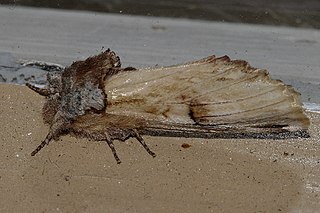Agrotis buchholzi, or Buchholz's dart moth, is a species of cutworm or dart moth in the family Noctuidae. It was first described by William Barnes and Foster Hendrickson Benjamin in 1929 and it is found in North America.
Acronicta dolli, or Doll's dagger moth, is a species of moth in the family Noctuidae. It was first described by William Barnes and James Halliday McDunnough in 1818 and it is found in North America.
Ursia furtiva is a species of moth in the family Notodontidae. It was first described by André Blanchard in 1971 and it is found in North America.
Afilia oslari is a species of moth in the family Notodontidae. It was first described by Harrison Gray Dyar Jr. in 1904 and it is found in North America.
Sympistis piffardi, the three-striped oncocnemis, is a species of moth in the family Noctuidae. It is found in North America.
Dichagyris socorro is a species of cutworm or dart moth in the family Noctuidae. It was first described by William Barnes in 1904 and it is found in North America.

Tripudia quadrifera is a species of moth in the family Noctuidae.

Theroa zethus is a species of moth in the family Notodontidae. It was first described by Druce in 1898 and it is found in North America.
Sympistis astrigata is a species of moth in the family Noctuidae. It was first described by William Barnes and James Halliday McDunnough in 1912 and it is found in North America.
Anarta inconcinna is a species of cutworm or dart moth in the family Noctuidae. It was first described by Smith in 1888 and it is found in North America.

Oligocentria pallida, the pale prominent, is a species of moth in the family Notodontidae. It was first described by Strecker in 1899 and it is found in North America.
Sympistis deceptiva is a species of moth in the family Noctuidae. It was first described by William Barnes and Arthur Ward Lindsey in 1922 and it is found in North America.
Zale bethunei, or Bethune's zale, is a species of moth in the family Erebidae first described by Smith in 1908. It is found in North America.
Lacinipolia aileenae is a moth genus or species of cutworm or dart moth in the family Noctuidae. It is found in North America.
Tripudia damozela is a species of moth in the family Noctuidae. It was first described by Harrison Gray Dyar Jr. in 1914 and it is found in Central and North America.
Anarta obesula is a species of cutworm or dart moth in the family Noctuidae first described by Smith in 1904. It is found in North America.
Aleptina semiatra is a species of moth in the family Noctuidae. It is found in North America.

Sympistis badistriga, the brown-lined sallow, is a species of moth in the family Noctuidae.
Zale aeruginosa, the green-dusted zale, is a species of moth in the family Erebidae. It is found in North America.
Tripudia goyanensis is a species of moth in the family Noctuidae.



